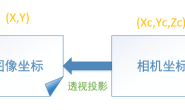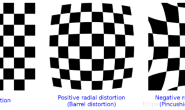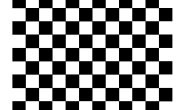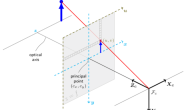一、标定实现
机器人工具坐标系标定就是确定工具坐标系相对于末端连杆坐标系的变换矩阵
1.1 TCP位置标定
 标定步骤
标定步骤
- 控制机械臂移动工具从不同方位触碰空间中某个固定点,记录N组数据(n ⩾ 3 n \geqslant 3n⩾3);
- 计算获得工具末端点相对机械臂末端点的位置变换;
1.2 TCF姿态标定
 标定步骤
标定步骤
- 完成位置标定;
- 控制工具末端点分别沿x方向和z方向移动一定距离,工具末端点只在该方向上有移动,其它方向上无位移,同时固定初始姿态保持不变。实际操作上可以设置三个固定点(三个固定点满足上述要求,点2和点3相对点1只有一个方向上的移动),使工具末端点分别触碰这三个点然后记录下机械臂末端位姿;
- 计算获得工具坐标系相对机械臂末端坐标系的姿态变换;
二、原理分析
末端连杆坐标系{E}到基坐标系{B}的位姿关系为:







三、程序实现
import numpy as np
import pandas as pd
import math
from scipy.spatial.transform import Rotation as R
class tool_cal():
def __init__(self):
"""
load data from csv
tool_points(0~5) : use robot effectors to touch the same points in the world
and record the pos
tool_poses_tran(0~3):count tanslation
tool_poses_rot(3~5):count rotation
"""
with open("tool_data.csv") as file:
tool_poses = pd.read_csv(file, header = None)
tool_poses = np.array(tool_poses)
# cal translation
self.tran_tran=[]
self.tran_rotm=[]
tool_poses_tran = tool_poses[0:4,:]
for pose in tool_poses_tran:
# set translation
self.tran_tran.append(np.array([[pose[0]],[pose[1]],[pose[2]]]))
# set rotation
r = R.from_euler('xyz', np.array([pose[3], pose[4], pose[5]]), degrees=True)
self.tran_rotm.append(r.as_dcm())
tool_tran=self.cal_tran()
# cal rotation
self.rot_tran=[]
self.rot_rotm=[]
tool_poses_rot = tool_poses[3:6,:]
for pose in tool_poses_rot:
# set translation
self.rot_tran.append(np.array([[pose[0]],[pose[1]],[pose[2]]]))
# set rotation
r = R.from_euler('xyz', np.array([pose[3], pose[4], pose[5]]), degrees=True)
self.rot_rotm.append(r.as_dcm())
tool_rot=self.cal_rotm(tool_tran)
# get transformation
tool_T = np.array(np.zeros((4,4)))
tool_T[0:3,0:3] = tool_rot
tool_T[0:3,3:] = tool_tran
tool_T[3:,:] = [0,0,0,1]
print tool_T
def cal_tran(self):
tran_data=[]
rotm_data=[]
for i in range(len(self.tran_tran)-1):
tran_data.append(self.tran_tran[i+1] - self.tran_tran[i])
rotm_data.append(self.tran_rotm[i] - self.tran_rotm[i+1])
L = np.array(np.zeros((3,3)))
R = np.array(np.zeros((3,1)))
for i in range(len(tran_data)):
L = L + np.dot(rotm_data[i],rotm_data[i])
R = R + np.dot(rotm_data[i],tran_data[i])
return np.linalg.inv(L).dot(R)
def cal_rotm(self, tran):
# centre
P_otcp_To_B = np.dot(self.rot_rotm[0],tran)+self.rot_tran[0]
# cal the dircction vector of x
P_xtcp_To_B = np.dot(self.rot_rotm[1],tran)+self.rot_tran[1]
vector_X = P_xtcp_To_B - P_otcp_To_B
dire_vec_x_o = np.linalg.inv(self.rot_rotm[0]).dot(vector_X) / np.linalg.norm(vector_X)
# cal the dircction vector of z
P_ztcp_To_B = np.dot(self.rot_rotm[2],tran)+self.rot_tran[2]
vector_Z = P_ztcp_To_B - P_otcp_To_B
dire_vec_z_o = np.linalg.inv(self.rot_rotm[0]).dot(vector_Z) / np.linalg.norm(vector_Z)
# cal the dircction vector of y
dire_vec_y_o = np.cross(dire_vec_z_o.T,dire_vec_x_o.T)
# modify the dircction vector of z
dire_vec_z_o = np.cross(dire_vec_x_o.T,dire_vec_y_o)
# cal rotation matrix
tool_rot = np.array(np.zeros((3,3)))
tool_rot[:,0] = dire_vec_x_o.T
tool_rot[:,1] = dire_vec_y_o
tool_rot[:,2] = dire_vec_z_o
return tool_rot
if __name__ == "__main__":
tool_cal()
参考
机器人工具坐标系TCP标定 四点法原理 与 matlab实现 机器人工具坐标系标定算法研究 广义逆矩阵A+




